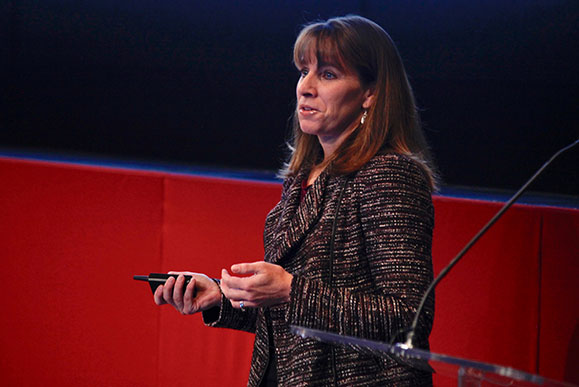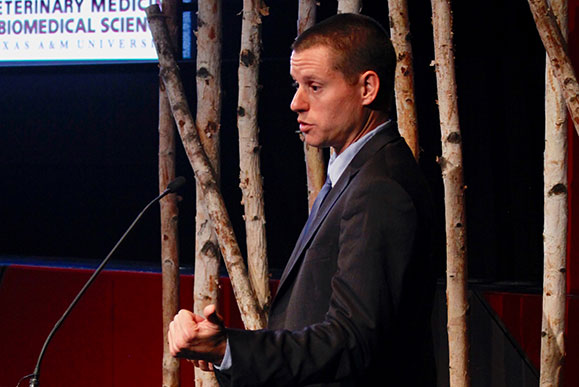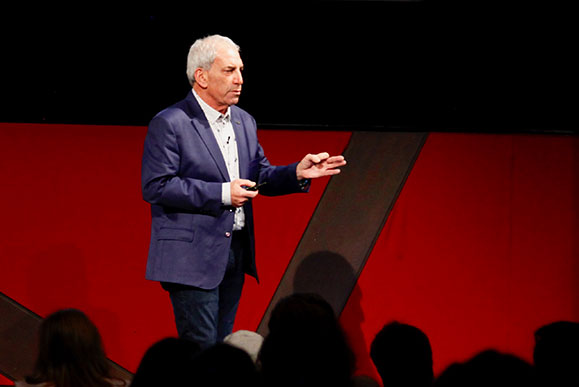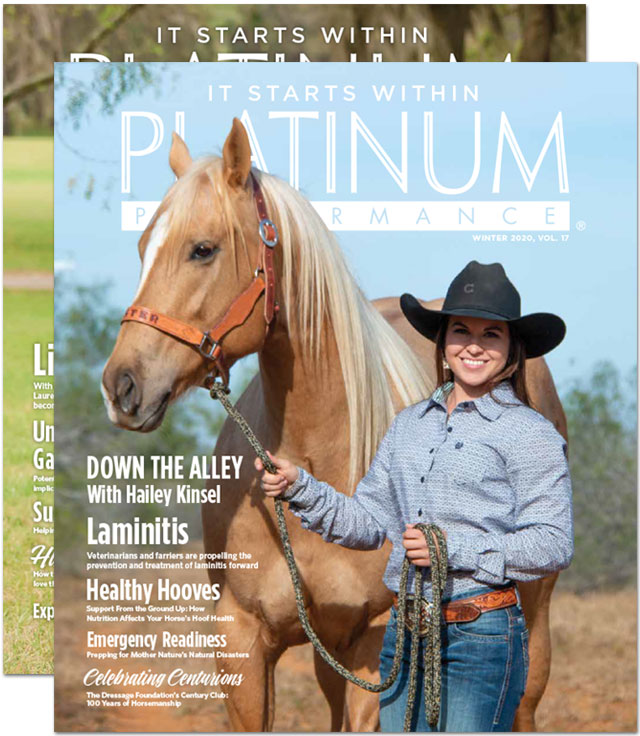Advancing a more predictive, preventative and personalized approach to equine — and human — health
Fresh into a new decade, equine veterinary medicine is on the cusp of what will potentially be its greatest era yet. This revolutionary time holds near limitless potential and the real promise of moving both equine and human health into an entirely new realm. The idea is simple. The execution is evolving and the impact could be vast. How do we treat and, better yet, prevent disease using a more predictive, preventive, personalized and participatory approach? The concept is known by various monikers — P4 Medicine, Precision Medicine, 21st Century Medicine and Scientific Wellness — with the commonality seen in the seismic shift that these movements are focused on making. Their goal is to transform the way that we predict, identify, prevent and treat disease in both animals and their human counterparts. Leading innovators in the field came together with over 300 veterinarians, researchers and physicians in Denver, Colorado, in early December 2019 for the inaugural Platinum Summit event to share, strategize and project how this novel approach to medicine could forever change the shape of patient care — in both humans and animals alike.
“While we may not do a microbiome screen tomorrow, the idea of thinking about our patients differently, and thinking about health and disease differently, that’s transformational. We’ll go home being a different doctor.”
— Dr. Richard Markell
Nutrition 3.0: Influencing Equine Biological Health
Like most things, to fully grasp the profound advancements that lay ahead of us, we need first to appreciate the great leaps we’ve made in equine veterinary medicine thus far. “My father liked to say that when he started practicing in the early 1970s, he had hoof testers and a stethoscope,” remembered Mark Herthel in his opening remarks at Platinum Summit. Herthel co-founded Platinum Performance® with his late father, renowned veterinary innovator, Dr. Doug Herthel. It’s ironic that basic veterinary tools such as hoof testers and a simple stethoscope transformed into Dr. Herthel’s passion for novel surgical techniques, bone-marrow derived mesenchymal stem cell therapy, hyperbaric oxygen therapy and next-level nutrition. “Today, equine veterinarians have equipment and resources in veterinary practice that are on par with the best in human medicine,” Mark Herthel continued. “We’ve come so far in a relatively short period of time.” These advancements include novel technologies, such as tech-forward diagnostic imaging, genetic sequencing, metabolome analysis and an ever-deepening understanding of the role and importance of the equine gut microbiome.
“We think of this evolution in three stages,” explained Mark Herthel. “We’ve moved from ‘Body 1.0’ to ‘Body 2.0’ and now on to ‘Body 3.0.’ — with Body 3.0 focusing on the biological systems that make up our being. In other words, we’re more than just the sum of our parts. We’re an interconnected collection of vital systems that works synergistically with one another.” Similar progression is occurring in the world of advanced nutrition and its impact on animal health. “For the first 15 years at Platinum Performance most of the results we could assess were on the surface of the horse — hair coat, body condition, hoof quality, behavior, movement, rate of healing and performance. That was ‘Nutrition 1.0.’ With the new research capabilities, over the last five years we’ve begun to see what’s happening inside the horse and how this affects outward health and performance; in other words, ‘Nutrition 2.0.’ We’re now evolving into ‘Nutrition 3.0,’” said Herthel. “This is an exciting time in which we are learning that advanced nutrition could become one of the most significant positive or negative modifiers of biological functions. Nutrition 3.0 will be a powerful tool for improving outcomes in equine patients.”
Recent research has added more dimension to how advanced nutrition can positively impact veterinary medicine. Now a standard of care in practice, advanced nutrition continues to be recognized in both scale and impact. Through years of research and countless clinical cases in the field, advanced nutrition has been shown to help optimize health for longevity, support reproductive success, and provide the body with crucial tools to both heal and perform to the fullest potential. This level of advanced nutrition starts at the cellular level by influencing the biological health of the entire horse. By using nutrition in both a preventive capacity as well as part of a treatment plan, veterinarians have succeeded in promoting health, performance and longevity in their equine patients. Veterinarians are integrating advanced nutrition to not only maintain healthy horses but to support athletes and complement clinical treatments in recovering patients.

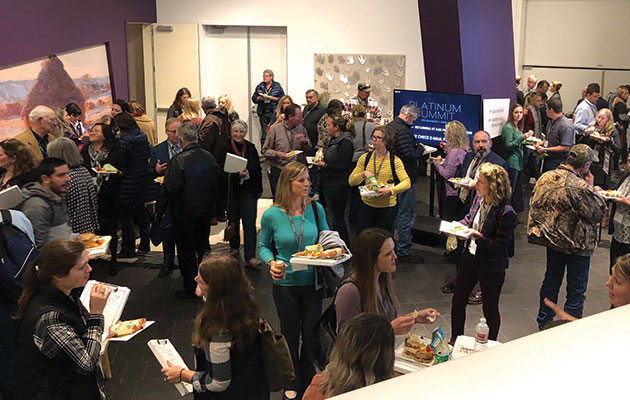
Over 300 veterinarians, researchers and physicians came together in Denver, Colorado, in early December 2019 for the inaugural Platinum Summit to share, strategize and project how this novel approach to medicine could forever change the shape of patient care.
Twenty-five time World Champion Cowboy Trevor Brazile gives his perspective as both a horseman and professional athlete.
Proactive vs Reactive: A New Frontier
Treatments targeted for sick or injured patients have made sizable gains in the last decade alone, as has our understanding of the equine athlete and the needs of elite performers. While the successful treatment of end-stage disease and injury will continue to be a significant focus, the aspiration of the scientific wellness community is to research the proactive treatments. These are the crucial early indicators that present themselves months and even years before an injury or disease becomes clinical or performance begins to diminish. Groups, such as that led by Dr. David Frisbie of Colorado State University, are fiercely dedicated to discovering predictive biomarkers that sound the proverbial alarm that a disease state or injury is imminent. These biomarkers have the capacity to provide this warning earlier than ever thought possible, allowing adequate time for prevention. The question then becomes, how exactly do we prevent disease from occurring or, at the very least, slow its progression? Several key factors come into play when practitioners and riders are working toward keeping a horse not only healthy but performing to its greatest potential for as long as possible. “We’re at a stage now where clients want stronger horses that will last longer. They want healthy horses, not just faster horses,” said Dr. Mark Revenaugh in his address at Platinum Summit. Dr. Revenaugh is the owner of Northwest Equine Performance and founder of the High Performance Sports Medicine Group and began working as a U.S. Team Veterinarian in the late 1990s with the eventing, jumping and driving teams. One of Dr. Revenaugh’s goals for the High Performance Sports Medicine Group was to reimagine the traditional treatment cycle most veterinarians use in practice. “If change is going to happen, it doesn’t happen by following the existing rules,” he said plainly. “It doesn’t matter how talented that horse or rider is if they’re not healthy and in the game.” Dr. Revenaugh and his fellow practitioners in the High Performance Sports Medicine Group spend a significant amount of time trading information with their colleagues in human sports medicine, learning what strategies, predictive diagnostics and technologies are being used with success in human athletics. “If we look at where human sports medicine is, we’re looking at keeping these athletes in a health cycle, and that’s not just training. It’s stress management, proper sleep and proper nutrition,” Dr. Revenaugh stated. “I remember when we had a top athletic trainer for an NBA team join us at a meeting for our group, and I wanted to know how he treats sprained ankles. I must have asked him five times. He kept saying, ‘We prevent them from happening in the first place.’ It took me a while to get it. But once it clicked, it changed my entire perspective.”
“The impetus for (Platinum Summit) is the continuing need to more fully understand the health issues facing horses, how better to treat them, and, most importantly, how to prevent them. Only by addressing these issues together will we be able to improve the long-term health of the horse and our industry. The overarching goal of today’s meeting is to start a conversation, to foster collaborations among horsemen and women, veterinary practitioners and care teams, veterinary academic researchers, human researchers and the equine industry.”
— Mark Herthel, Co-Founder, Platinum Performance, Inc.
Precision Medicine
The minds behind the movement recognize that in order to create change, veterinarians must shift thinking from primarily symptom management and treatment of end-stage disease to a practice that focuses heavily on early detection, prevention and a personalized approach to treatment. There is no one-size-fits-all solution but rather a highly individualized approach based on data and advanced diagnostics, such as genome sequencing and deep phenotyping, to name just a few of the seemly futuristic tools that are available and changing lives today. “This is a topic that, as equine practitioners, we’re ready to delve into,” said Dr. Carrie Finno, as the first presenter at Platinum Summit. Dr. Finno is the Director of the prestigious Center for Equine Health at the University of California, Davis. “The terms ‘precision medicine’ and ‘personalized medicine’ get used interchangeably. They’re very similar but have distinct differences as well. In the case of personalized medicine, you actually have a person diagnosed — say in the case of cystic fibrosis — with a sweat test or with a genotype. They get a specific treatment, and they have these sort of ancillary treatments that are included,” she explained of a scenario considered to be personalized medicine. “With precision medicine, you have the same thing. But, if we think about it, you can actually have this spectrum of phenotypes, which they call endotypes, and that’s related to not only that genetic mutation but also to modifier genes. As we all know, environment and lifestyle also play a huge role in disease as well. The goal of precision medicine is actually to look at all of these factors. What you can then do is say ‘OK, this particular individual is likely to respond to this drug but not these drugs.’ You can actually take it a step further and move on to gene therapy and targeted treatment. That’s incredibly powerful to be able to target treatments to an individual.”
The goal is for practitioners to one day — sooner rather than later — have the ability to more readily offer whole genome sequencing and other advanced diagnostic tools that give them a more complete picture of that patient as an individual, paving the way for a precise diagnosis and blueprint as to what therapies will be most effective or not effective at all. “Say we have six horses with superficial corneal ulcers,” explained Dr. Finno further. “We’re going to treat them with topical ointment and, likely, we will initiate treatment with a full dose of Banamine or flunixin meglumine at 1.1 mg/kg PO BID — an anti- inflammatory non-steroidal drug. In most of these horses, we will achieve an anti-inflammatory effect. But in one or two of these horses, we will not achieve that anti-inflammatory effect. Then, there may be an unfortunate horse that goes into acute renal failure or develops a gastrointestinal disturbance, and we don’t know why. Why did that horse, who was on the same dose and was adequately hydrated, have this outcome? I would argue that this is where the field is going to move to. We need a cost-effective way to take those same six horses and start being able to use biomarkers that are banked on DNA, proteome, metabolome, microbiome, tissue analysis and the integration of those results. We can then start targeting therapies,” said Dr. Finno. “Those four horses may still get that same dosage of flunixin, but those outliers may get half that dose or a different drug entirely; they may need Ketoprofen and not Banamine. The goal would be to get the same positive effect in all of the horses but to use precision medicine to determine how to treat them.” The idea of precision medicine has the potential to transform the way that therapies are chosen and targeted to individual animals based not only on their clinical condition, but on their unique body chemistry and genes. While sick and injured patients will undoubtedly benefit from this tailored approach, high-performance athletes could experience a new level of preparedness and injury avoidance as well.
The human medical landscape is brimming with examples of how precision medicine could greatly impact patient outcomes by crafting customized treatments based on patient needs rather than what has “worked” for a certain percentage of the population. Does one size fit most? Maybe. Does one size fit all? Almost never. Take Tamoxifen®, for example. This drug has been a mainstay for breast cancer patients as a means to treat and theoretically help prevent reoccurrence. “It’s now known that up to 65 percent of women develop resistance to Tamoxifen due to a mutation in the CYP2D6 gene that metabolizes the drug. Women with these genetic mutations can’t break down this drug into its active metabolite,” pointed out Dr. Finno. “Because of this, they can actually have treatment failure.” Thanks to developments such as this, however, women can now be screened or genotyped for this mutation before treatment is assigned. Imagine the lives this precision medicine approach will impact in this scenario alone, considering how frequently this drug is prescribed.
Scientific Wellness
Dr. Nathan Price of the Hood-Price Lab at the Institute for Systems Biology joined the line-up of experts in the field at Platinum Summit to share a deeper perspective from the human medical realm. “Most of medicine really focuses on late-stage disease. Our contention is that in the 21st Century moving forward, medicine should really focus on early intervention. What we ultimately want to do is to discover what’s happening in those earliest transition states into disease, then figure out what we can do 20 years before these diseases present themselves,” he said passionately. The challenge presented to him and his team at the Hood-Price Lab was in the form of practicality. “How do we turn this concept into something practical,” Price asked, rhetorically during his lecture. “Lee Hood and I undertook a project to do so a few years ago.” Lee Hood is Price’s research partner, the incredible mind that invented the automated DNA sequencer and the man credited as the father of systems biology. “The notion was to assemble 100 people and do a bunch of ‘omics’ on them. We did whole genome sequencing on everybody and 1,200 different analytes — proteins, metabolites and clinical labs out of the blood — gut microbiome and wearable devices. In the short run, the goal was to show that there were enough actionable possibilities that you could pull from this. Long-term, our goal was to create personal dense dynamic data clouds, or deep phenotyping, so that we have these data clouds with lots of data for every person that we could use to then engage with them in a scientific wellness program. We wanted to monitor how these data clouds changed as they undertook behaviors that were either helpful for their health or they underwent a transition into disease,” explained Price.
An example of Price and Hood’s work can be seen in the gut microbiome, which is the collection of microorganisms, bacteria, viruses, protozoa and fungi — and their genetic material — that are present in the gastrointestinal tract. The gut microbiome is being hailed as the epicenter of health in both humans and horses. “This approach gave us a lot of information about not only the microbiome but also the host,” said Price. “One of the first things we did was to look at alpha-diversity of the microbiome. In general, the more diverse the microbiome the better, although there is a limitation to that. What we set out to do was to see if we could predict the alpha-diversity of the gut microbiome from the blood. We found we could do that quite well. We can capture half of the variants of the gut microbiome’s diversity from a set of between 11 and 40 metabolytes.” What proved even more striking to Price, Hood and their team was when they looked at the manner in which this measurement changed for an individual or based on a number of different diseases or conditions (antibiotic usage, abdominal pain, diabetes, etc.) “In every single case, the direction that it moved, either to higher or lower diversity, was mirrored by the score we estimated out of the metabolome. What this argues is that you can potentially predict quite a lot about the gut microbiome’s function by what you see in the host. I actually believe that the test we’ll ultimately run to see if you have a healthy microbiome will actually not be a microbiome test. It’ll be a blood test,” says Price confidently.
The Impact of Advanced Nutrition
Significant work has been performed in horses to study the importance of the gut microbiome as well. While the unknown remains vast, there are new discoveries being made constantly that tell us that not only is the gut microbiome a key indicator of health in the horse, but it can play a role in numerous conditions veterinarians are faced with regularly. Dr. Canaan Whitfield of Texas A&M University recently studied Phenylbutazone®-induced gastrointestinal injuries in horses. “I studied this because gastrointestinal disease is a leading cause of morbidity and mortality in horses. In fact, it’s second only to old age as a cause of death,” said Dr. Whitfield in his address at Platinum Summit. “The equine gastrointestinal system is complex both structurally and functionally,” explained Dr. Whitfield. “It’s about 100 feet long and composed of many different anatomically diverse regions. It’s not simply a tube for passing feed from one end of the horse to the other. There’s a very complex microstructure.” The microorganisms in the GI tract are termed “microbiota.” Horses host up to 1015 bacteria in their GI tracts — a massive number. “What’s amazing is that in both humans and animals our cells are outnumbered dramatically by the amount of genes in the microbiota.” More importantly than its sheer size is the gravity of the gut microbiome’s role in equine health. Horses, being hindgut fermenters, rely on these crucial micro- organisms for digestion of feed, intestinal health and less obvious areas, such as several non-GI-specific diseases and also performance. The health and diversity of the gut microbiome has been shown to directly impact colic, colitis, obesity and laminitis, while being easily altered by medications — antibiotics and NSAIDs specifically — diet, transportation and environment, including seasonal variation, hay and other factors. “In human medicine, they’ve definitively linked changes in gut microbiota to several diseases, including autism, cardiovascular disease, various types of cancer and certainly GI diseases,” said Dr. Whitfield, who then detailed the recent study on Phenylbutazone®-induced gastrointestinal injuries in horses that he and his team completed at Texas A&M University
In that study, there were three groups of 10 horses each for a total of 30 horses — (1) a Phenylbutazone ® group, (2) a Phenylbutazone® plus nutritional therapeutic group and (3) a control group. The horses in group two were preconditioned with a nutritional therapeutic from day 0 to day 50, which included omega-3 fatty acids, antioxidants, prebiotics, probiotics and glutamine. On day 50, the team administered a 10-day course of Phenylbutazone® or placebo, then after 10 days the study ended. “We looked at a number of things. The first of which was a biomarker of the permeability of the intestinal mucosa, or ‘leaky gut,’ ” explained Dr. Whitfield of his findings. “In the control group, there was no significant change in this biomarker of intestinal permeability. In the Phenylbutazone group, however, there was a significant increase at the five-day point, suggesting that there was a temporary induction of impaired intestinal permeability. When we gave the nutritional therapeutic to this group, there were no significant changes in this biomarker over the 10-day period in which they were receiving Phenylbutazone,” outlined Dr. Whitfield. “We know that NSAIDs cause gastric ulceration, so we looked at that as well. The control group saw no changes. In the Phenylbutazone group, we saw a significant increase in gastric ulcer scores after 10 days.” Lastly Dr. Whitfield and his team looked at the dysbiois caused by NSAIDs. “We had a few changes in the bacteria of the control group, a number of bacterial changes in the Phenylbutazone ® group and there were no significant changes in the nutritional therapeutic group,” Dr. Whitfield concluded. The gravity of these findings was immediately realized by the crowd of veterinarians watching Dr. Whitfield detail his findings.
NSAIDs, like antibiotics are used daily in equine medicine, as they are in human medicine as well. Not only does Dr. Whitfield’s research show the side effects of NSAID therapy, but more than that, it proves that those common and detrimental side effects can be ameliorated or combated using the right advanced nutrition.
Using Food as a Clinical Tool
Joining veterinary researchers at Platinum Summit was a superstar in the world of human functional medicine, Dr. Mark Hyman, Director of Strategy and Innovation for the renowned Cleveland Clinic for Functional Medicine and a New York Times best-selling author many times over on the subject. He drew key parallels between the true impact that diet has on disease in both humans and animals. “Biology is biology, and we have much more in common with animals than we think,” said Hyman.
For decades Hyman and his colleagues have been focused on changing thinking through hard science and patient success in the field. “We have to focus on a different paradigm in how we treat patients, which is based on a different framework,” he said insistently. “Rather than focus on disease, we focus on health.” Hyman’s work has been driven by the goal of finding a better way to activate healing mechanisms in the body. He’s a vocal supporter of the scientific wellness movement and sees striking similarities between it and the ethos of functional medicine, which is a root cause approach to medicine that relies on treating the body as a connected network of systems. “What we’re learning now is that our current theories and approaches to diagnosing and treating disease don’t really make sense anymore,” said Hyman, speaking of modern mainstream medicine. “Functional medicine takes these emerging concepts around systems biology and the body as a series of biological networks and puts it into a methodology or a framework that you can use to evaluate and treat patients.” His excitement is palpable when speaking on the subject that has defined his life’s work. “We’re now seeing a convergence of a number of different phenomena that are going to radically transform medicine and health care,” he explained. “The first of which is the ‘omics revolution,’ which is metabolomics, proteomics, the microbiome and genomics. It’s the ability to take big data, including quantified self-data and biometrics, organize it using artificial intelligence to make sense of it all, then draw critical conclusions from it,” Hyman detailed.
Dr. Hyman has also set out to redefine the hold that our genetics have on us. While genes are of great importance in determining our predisposition to certain conditions, we are by no means prisoners bound and determined to be afflicted with the ailments of our relatives. “It turns out that a lot of our health is not necessarily driven by our genes, but rather, what happens to those genes, or the exposome,” explained Dr. Hyman. “The exposome is the total sum of influences that wash over you during your life. It’s your prenatal influences, early childhood, what medications you’ve taken, what is going on in your microbiome, the toxins you’ve been exposed to, the food you’ve eaten, how you’ve exercised, the stress you’re under. All of those things influence our gene expression and determine who we are. It is these influences, or the exposome, that drives 90 percent of human disease, rather than the genome. The question is, how do we make sense of all of this?” asks Hyman rhetorically.
Hyman’s driver, and that of those like him, is to take the complexity out of human biology to better interpret the big data now at our fingertips and translate it into real results for real patients. “We have to think differently about how we treat people. Instead of our current system of classification of diseases, which really just describes symptoms, we should switch to classifying diseases by mechanisms, causes and networks,” he says emphatically. Calling Hyman hopeful would be a mischaracterization. He’s wholly committed and entirely convinced that the days of traditional medicine — the days of treating a symptom with a pill — are quickly going to become days of the past. “In functional medicine, we are creating what we call a matrix. It’s how we sort and sift and analyze the data. We look at the predisposing factors: genetics, trigger events, insults and so forth. We then look at lifestyle factors and how they influence our fundamental biological networks. These are systems that are all connected, they’re not separate.” When Dr. Hyman sees a patient he first filters them through this lens, allowing him to better and more efficiently determine what is beneath the surface, what’s really going on to cause the symptoms they’re experiencing.
While Dr. Hyman and his colleagues are reinventing the diagnostics process, the question then becomes, how do they produce results in the patient — how do they make them better? “The most important biological response modifier that influences every single one of these symptoms is food. Food is critically important. It’s not like medicine — it is medicine,” says Hyman, quite confidently. “Here’s the deal, for most patients we see, there’s a powerful drug that helps improve gene expression, optimize hormones, regulates all of our cytokines, improves our proteomic expression and optimizes the microbiome. It’s available to almost everyone on the planet. It’s very cheap. It has almost no side effects. It’s food. This is what food does. It is the most powerful drug on the planet. It’s really the best medicine, whether we’re talking horses or humans.” While Hyman focuses on treating patients through deep testing, interpretation of large data, lifestyle modification and using food as medicine, his impact goes further than treating disease. He is pouring his passion, reach, time and expertise into retraining both physicians and the public that there is a better way to treat, an improved approach to medicine and an avenue out of the dark and uncertain cave of disease. There’s a bright future for medicine, and the future may rely heavily on something so simple: food.
A key area of medicine currently proving Dr. Hyman’s theories to be correct is seen in the field of reproductive science. For several years Dr. Elaine Carnevale’s team at Colorado State University has been focused on impacting fertility rates — particularly in senior subfertile mares — using nutrients such as omega-3 fatty acids, antioxidants, vitamins and trace minerals, along with specific nutrients such as alpha lipoic acid (ALA), omega-3 Docosahexaenoic Acid (DHA) and L-Carnitine. Dr. Carnevale presented recent findings to the audience at Platinum Summit together with Dr. Adam Chicco, an exercise physiologist and mitochondrial specialist, and Dr. Rebecca Krisher, a human reproductive biologist at the Colorado Center for Reproductive Medicine. Together they shared new insights into how these nutrients can impact reproductive success by impacting the horse at the cellular level. With the ever-present issue of infertility in both horses and humans, it was clear from their lecture that nutrition is a pivotal tool when dealing with fertility issues in both species.


Food is medicine. Right, International Grand Prix Rider Karen Polle recognizes the power of nutrition. She's been a Platinum Performance® client since 2014.
Spurring Progress
While Platinum Summit focused heavily on the future of veterinary medicine, the concept of innovation is, in many ways, nothing new to veterinarians.“I think the takeaway is that veterinarians are innovators. We’ve had to be,” said renowned veterinarian, Dr. Richard Markell, in his closing remarks from the stage at Platinum Summit. “What I’m so proud of is being here in a group of people that’s remarkable. We’re all here learning a new way of thinking, a new way of looking at health, disease and treatment. While we may not do a microbiome screen tomorrow, the idea of thinking about our patients differently, and thinking about health and disease differently, that’s transformational. We’ll go home being a different doctor.” While Dr. Markell has always had his finger on the pulse of technology and a deep interest in what’s next on the horizon in terms of treatments, he first values the veterinarian as the ultimate influence on equine health, performance and recovery. “The future of medicine is really 50 percent technology and innovation, and the other 50 percent is us. How do we change the way we think as veterinarians, and the way we approach health and disease? Uber changed the way we take taxis, Tesla changed the way we drive cars overnight, and who would have thought solar would have become what it is. These breakthroughs are amazing, but it’s the way we use them that matters.” As Dr. Markell walked off the stage he turned and said earnestly, “I’m so proud to be a veterinarian, and I’m so proud that we’re all here listening to new ways of thinking and new ways of doing things. We’re looking at horses in a new way. It’s not just a leg, it’s a horse. I promise this new view will be more successful with better outcomes.”
Thanking Dr. Markell with a handshake, Mark Herthel addressed the audience to close out what had been an incredible day — a day that was set into motion over five decades earlier with Dr. Doug Herthel, a pair of hoof testers, a stethoscope and a head full of ideas. He and so many of his colleagues reshaped the way that veterinary medicine was practiced, the way fractures were repaired, colics were approached, wounds were healed and performance athletes were fed and conditioned. “The impetus for today’s meeting is the continuing need to more fully understand the health issues facing horses, how better to treat them, and, most importantly, how to prevent them. Only by addressing these issues together will we be able to improve the long-term health of the horse and our industry. The overarching goal of today’s meeting is to start a conversation, to foster collaborations among horsemen and women, veterinary practitioners and care teams, veterinary academic researchers, human researchers and the equine industry.”

by Jessie Bengoa,
Platinum Performance®
You May Also Like

Food is Medicine: The Emergence of Functional Medicine
Using food and therapeutic nutrients as medical therapy is growing in popularity and practice.
Read More
The Science of Sport
The Evolution of How We Treat, Condition & Feed the Competitive Athlete.
Read More
Gut Check
The microbiome and its future in veterinary medicine; Three elite research veterinarians weigh in.
Read More

